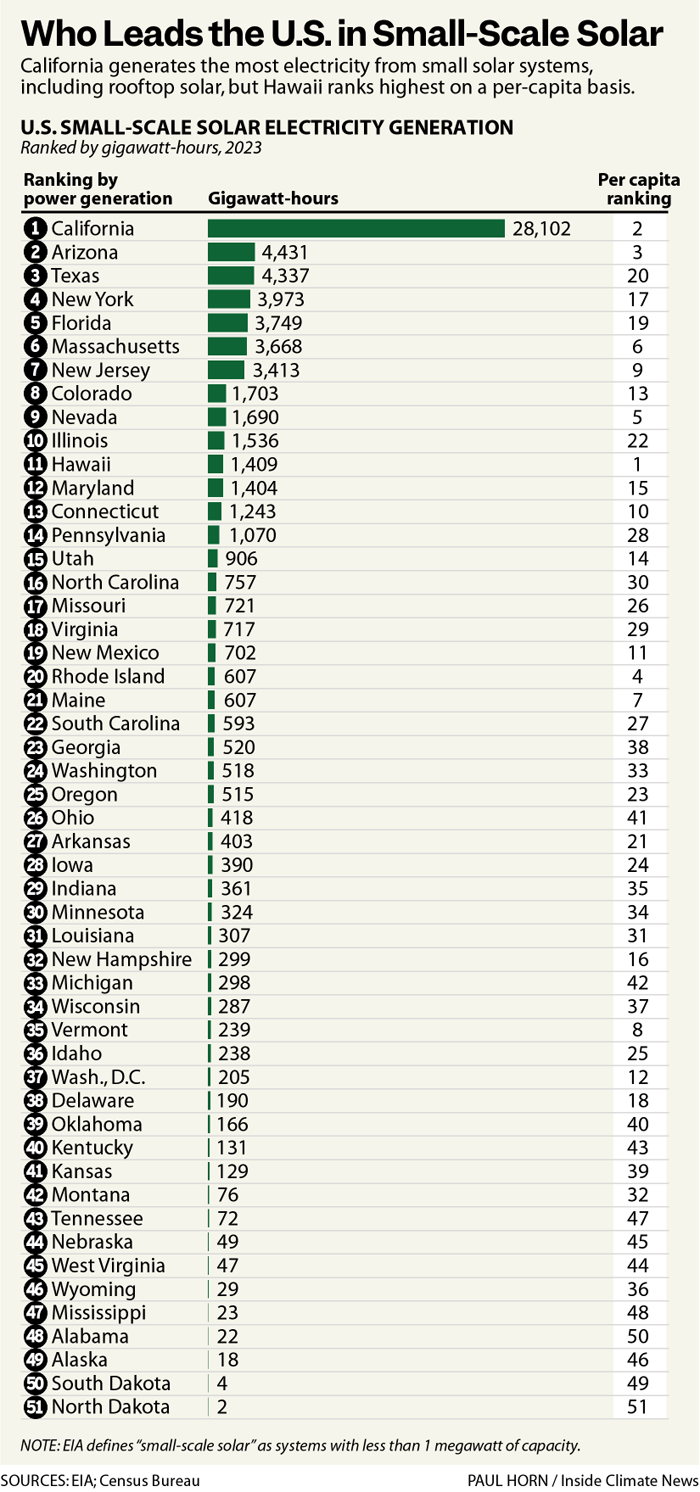Rooftop Solar Was Having a Moment in Texas Before Beryl. What Happens Now?
While much of the Houston area suffered through heat and electricity failures following Hurricane Beryl last week, Bill Swann never lost power.
He could depend on the 16 solar panels mounted in his backyard and a battery system to provide for the basic needs of his house in the suburban community of Hilshire Village.
Asked if his neighbors are envious, he said he doesn’t know. Most of them have left their homes until the utility, CenterPoint Energy, is able to restore electricity.
“I love to brag about the fact that I’m living off of solar,” he said.
Solar aficionados in the area may know Swann as someone who runs free workshops about rooftop solar. He is a retired mechanical engineer, and one of his hobbies is designing and building solar systems, including his own.

He was one of the people I reached out to this week to get a sense of whether Beryl, along with longer-term concerns about the reliability of the grid, have made Texans more receptive to rooftop solar.
Such customer-owned resources are an essential part of the shift away from fossil fuels, helping to reduce demand on a grid that relies on natural gas power plants to produce electricity.
Texas ranks third in the country in electricity generation from small-scale solar, including rooftop solar, trailing California and Arizona, according to the Energy Information Administration. (The federal office defines small-scale solar as systems with capacity of less than 1 megawatt.)
On a per-capita basis, however, Texas ranks 20th, which indicates that there is a lot of room to grow. How much room is difficult to say, but a good way to frame it is that the state’s generation from small-scale solar last year was equivalent to about 1 percent of the total from large power plants.
The state has the technical potential to cover more than 30 percent of its electricity consumption with rooftop solar, according to a 2018 paper from the National Renewable Energy Laboratory. I’m cautious in citing this figure because the underlying data is more than a decade old, and because technical potential is usually a lot more than markets or consumer preferences will bear. An official at the lab tells me researchers there are working on an update to this research, which may be available next year.

In recent years, Texas has increased its electricity generation from small-scale solar at a rapid pace. In 2023, the state generated 4,337 gigawatt-hours from this category, an increase of 45 percent from the prior year, according to EIA. Of the 10 states with the most generation from small-scale solar last year, only Florida had more percentage growth, with 47 percent.
“I think the public is ready to embrace a paradigm shift in how we manage power distribution in Houston,” said Rafael Lemaitre, spokesman for Power Up Harris County, a coalition of labor and community groups that want to expand the use of rooftop solar and other distributed energy technologies in greater Houston.
“I don’t think most people know what distributed energy distribution is,” he said, referring to a term that includes resources such as rooftop solar. “But what they do know is the current status quo isn’t working, and they’re thirsty and eager for change.”
Houston is among the cities getting a substantial boost in funding for rooftop solar and community solar from the Biden administration’s Solar for All program, which is providing about $250 million to a Harris County-based group of nonprofits. The beneficiaries will mainly be low- and moderate-income households.
Texas has done little to encourage development of rooftop solar through state or local tax breaks or policies, but residents can receive federal benefits such as the investment tax credit, which is worth 30 percent of the cost of a system.
Explore the latest news about what’s at stake for the climate during this election season.
Some of the main drivers of rooftop solar in Texas have been a desire to reduce exposure to rising utility costs and concerns about reliability of the grid, said Ryan Barnett, senior vice president of policy and market development for Palmetto, a North Carolina-based climate tech company whose products include solar and battery storage.
“Texas is a fast-emerging behemoth of a distributed energy resource market,” he said.
His company saw a big increase in interest from Texas customers following the 2021 winter storm that led to power outages. Palmetto is active in more than 20 states.
“As reliability suffers, and consumers lose power more often or for longer periods, their interest in technologies and equipment that can provide them with better resiliency surges,” he said.
Beryl is likely going to increase the momentum that already was building in Texas, he said.
Another key variable is that the costs of solar and storage have mostly been flat while utility costs continue to rise. A solar system may cost about $20,000, but the savings on electricity bills will cover the costs in less than seven years, according to EnergySage.
The discussion of costs is part of the argument that Bill Swann has been making to anyone who will listen for more than a decade. He said it’s much easier to convince people these days.
“There’s a strong economic case for solar,” he said. “The payoff is usually about 8, 10, 12 years. … And then after that, it’s free energy.”
Other stories about the energy transition to take note of this week:
Trump’s Environmental Impact Endures, at Home and Around the World: The outcome of the U.S. presidential election could shift the trajectory of the country’s transition away from fossil fuels. Part of understanding what may be ahead is to look at what the Trump administration did, as my colleague Marianne Lavelle does with this story.
Trump Talks EVs and Automotive Trade: Former President Donald Trump spoke at length with Bloomberg Businessweek about a variety of topics. Craig Trudell of Bloomberg highlights the parts of the conversation about EVs and automotive trade, showing how Trump veers between saying he has “no objection to the electric vehicle” to attacking EVs because of concerns about range, their weight and their high prices. It’s a potential preview of what Trump may do if elected in November. He has said he will undo Biden administration policies that support EVs.
Can the New Nuclear Law Remake the Industry? The ADVANCE Act, signed by President Joe Biden last week, aims to streamline permitting for new nuclear reactors, increase the resources available to the Nuclear Regulatory Commission and promote U.S. nuclear power technology around the world. Zack Bright of E&E News reports on the potential effects of the law, based on interviews with people in the nuclear industry and environmental groups.
Don’t Blame Clean Energy for Rising Electric Bills: A new report from the think tank Energy Innovation shows how the growth of renewable energy is not to blame for rising electricity prices, even if Republican lawmakers and fossil fuel advocates say otherwise. The main drivers of electricity rate hikes are the rising costs of maintaining and expanding grid infrastructure and spikes in fossil fuel prices, as Jeff St. John reports for Canary Media.
Electric Vehicles May Become Harder to Rent: Renting an EV may soon become more difficult as rental companies have scaled back inventories, Jack Ewing and Dionne Searcey report for The New York Times. Hertz is a notable example, having scaled back plans to acquire 100,000 Teslas after the cars’ resale values fell more than the company expected. Some rental companies are selling their EVs at deep discounts, which is good for buyers, but it reduces resale values even more to have these vehicles entering the used car market.
Inside Clean Energy is ICN’s weekly bulletin of news and analysis about the energy transition. Send news tips and questions to [email protected].
About This Story
Perhaps you noticed: This story, like all the news we publish, is free to read. That’s because Inside Climate News is a 501c3 nonprofit organization. We do not charge a subscription fee, lock our news behind a paywall, or clutter our website with ads. We make our news on climate and the environment freely available to you and anyone who wants it.
That’s not all. We also share our news for free with scores of other media organizations around the country. Many of them can’t afford to do environmental journalism of their own. We’ve built bureaus from coast to coast to report local stories, collaborate with local newsrooms and co-publish articles so that this vital work is shared as widely as possible.
Two of us launched ICN in 2007. Six years later we earned a Pulitzer Prize for National Reporting, and now we run the oldest and largest dedicated climate newsroom in the nation. We tell the story in all its complexity. We hold polluters accountable. We expose environmental injustice. We debunk misinformation. We scrutinize solutions and inspire action.
Donations from readers like you fund every aspect of what we do. If you don’t already, will you support our ongoing work, our reporting on the biggest crisis facing our planet, and help us reach even more readers in more places?
Please take a moment to make a tax-deductible donation. Every one of them makes a difference.
Thank you,
David Sassoon
Founder and Publisher
Vernon Loeb
Executive Editor
Share this article
Disclaimer: The copyright of this article belongs to the original author. Reposting this article is solely for the purpose of information dissemination and does not constitute any investment advice. If there is any infringement, please contact us immediately. We will make corrections or deletions as necessary. Thank you.
Title:Rooftop Solar Was Having a Moment in Texas Before Beryl. What Happens Now?
Url:https://www.investsfocus.com




